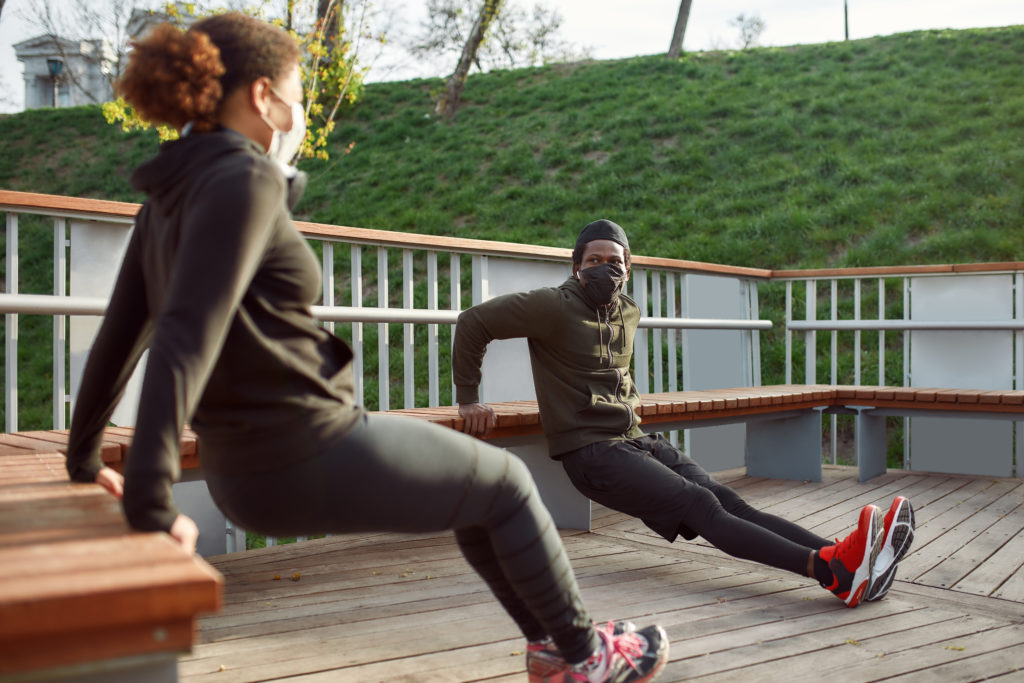As we continue to cope with a pandemic, it’s important to acknowledge that feeling stressed, worried or anxious is valid. If you have found yourself with less time, energy or motivation to workout, it’s understandable.
Exercise is important for a variety of reasons that many of us already know: it can protect against heart disease and type 2 diabetes, strengthen bones and muscles, reduce the risk of some cancers and help achieve and maintain a healthy weight.
It can also help us manage stress, anxiety and depression, which can be particularly helpful when there’s so much uncertainty, unrest and stress in our lives. This blog post focuses on the connection between physical activity, mental health and brain health.
Physical Activity and Stress
Physical activity can reduce our bodies’ levels of cortisol and adrenaline, which are stress hormones. It can also increase our levels of serotonin, dopamine, endorphins and gamma aminobutyric acid (GABA) which help us feel better.
- Serotonin helps regulate mood, boost happiness and suppress anxiety.
- Dopamine boosts our mood, motivation and attention.
- Endorphins elevate mood and reduce feelings of physical pain.
- Gamma aminobutyric acid (GABA) helps create a feeling of calmness; studies suggest it can be increased by practicing yoga.
Additionally, physical activity can help alleviate physical symptoms of stress like back pain or muscle tension. More restful sleep can also be a positive side effect of moving more!

Physical Activity and Mental Health
Physical activity can help improve mental health, whether you are living with a mental illness or not. Though the positive effects of physical activity may vary from person to person, regular movement can be a strategy to boost mood daily.
Just working out once can cause your body to increase levels of serotonin and dopamine, which can help increase your ability to focus and remember things for up to three hours after you’re done.
Physical activity can also complement any mental health treatment plan. One out of five adults in the United States will experience mental illness in their lifetime. The most prevalent mental illness are anxiety disorders and depression.
Working out for ten minutes can help decrease anxiety from high to normal levels. This is important because you can strategically use short breaks of physical activity to help lower anxiety levels and manage stress.
Though living with a mental illness can make it more difficult to stay physically active, all efforts benefit the brain and body.
Physical Activity and Brain Health
In addition to helping reduce stress and boosting mental health, physical activity can also improve the health of the brain in the following ways:
- Production of new brain cells
- Improvement in long term memory
- Protection against Alzheimer’s disease
- Protection against dementia

Breaking It Down to Manageable Amounts
The physical activity recommendation for adults is 150 minutes of moderate intensity activity per week. Moderate intensity means you can feel your heart beating faster.
Adults are also encouraged to do muscle strengthening exercises twice a week.
If you don’t already have an exercise routine, this can seem like a lot of movement to add into your week! The good news is you can break the 150 minutes down into manageable amounts. By starting small, you can build on your successes and gradually increase how long you’re physically active.
One tool for breaking down new healthy habits is the Simple, Simpler, Simplest model by Dr. Troy Adams, Chief Operating Officer of WellSteps. By breaking healthy behaviors down to their smallest parts, you can more easily add them into your day. For example, walking a mile each morning might be difficult. Parking father away from stores so you have to walk farther is easier. Though the benefits are not the same, a habit you can maintain is sustainable, and you can build on your success with time.

James Clear, author of Atomic Habits: An Easy and Proven Way to Build Good Habits and Break Bad Ones, suggests four considerations for creating a new healthy habit.
- Make it obvious – If you’re trying to eat more vegetables, preparing them in small bags or containers and putting them at the top of your lunchbox or front of the fridge can help make the easy choice more obvious. Pairing your new habit with a location, such as the front of the fridge, or a certain time, like during your lunch break, can help you stick with it.
- Make it attractive – Pair your new habit with something that brings you pleasure. If you’d like to get out and walk more, the perfect playlist, audiobook or podcast can help the time pass while you get your steps in. You could also go walking with a friend to boost your social well-being and make the exercise more engaging. Unplugging during your walk and practicing forest bathing can also be a relaxing way to enjoy a walk away from traffic and neighborhoods.
- Make it easy – Setting yourself up for success with a new habit doesn’t have to be a long process. What little adjustments can you make to your environment to make a good habit easier? Having spare walking shoes at work or in your car, driving home past a park or the gym and laying out your workout clothes at night can all be cues that help you stick with your healthy habit. Placing floss near your toothbrush, laying out your yoga mat or having a water resistant jacket or umbrella in your car can help you eliminate the excuses to not stick with your new habit.
- Make it satisfying – We are more likely to repeat healthy behaviors that make us feel better instantly. However, it can often take time for us to the see results, which can make us feel discouraged. What are healthy ways you can make a new habit feel good instantly? You might need to try different types of floss to see which feels the best. Having a pitcher of water infused with fruit and herbs might be a refreshing way to end a daily walk. Small, instant rewards can help reinforce your new habit until you’re more intrinsically motivated and used to the new routine.
Many healthy habits take time and nurturing to stick, so it’s important to practice self-compassion with ourselves when we don’t follow through. However, by adding more physical activity to your day, you are caring for your brain, body, mental health and overall well-being.
Free Resources for Staying Active
- DeskFit: 20 Essential Desk Exercises You Can Do Without Leaving Your Office or Home Workspace – NASA
- Physical Activity Breaks for the Workplace – Center for Disease Control
- Ideas for Physical Activity Breaks at Meetings – David Douglas School District
- Yoga Videos for All Levels – Yoga with Adriene
- Yoga, Pilates and Fitness Videos – Gaiam
- Find a State Park – Oregon State Parks

References and Related Reading:
Hope, Happiness and Social Connection: Hidden Benefits of Regular Exercise – NPR
Why You Brain Loves It When You Exercise, Plus 3 Easy Ways to Work Out at Home – TED
How Dopamine Influences Behavior – Psychology Today
What is Serotonin? – Hormone.org
The Neurochemicals of Happiness – Psychology Today
Exercising to Relax – Harvard Health Publishing
Why Physical Activity Matters – Centers for Disease Control
Exercise for Mental Health: 8 Keys to Get and Stay Moving – National Alliance on Mental Illness
Mental Health Infographic – National Alliance on Mental Illness
Benefits of Physical Activity – Centers for Disease Control

